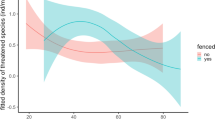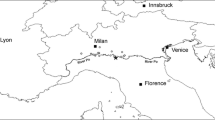Abstract
Plant translocation has become a widely used tool to improve the conservation status of threatened plants. Dianthus morisianus (Caryophyllaceae) is a narrow endemic plant which only grows on the Portixeddu coastal dune (South-West Sardinia). Its natural habitat has been strongly modified, and it is currently considered one of the most threatened plants of Sardinia. In a conservation effort, a translocation of reproductive plants was planned. Plants were obtained from seeds collected in the natural population and cultivated at the Botanic Gardens of Cagliari University. The following two suitable areas near the natural population were identified: the first is located in a fenced site which is managed by public administration, and the second is located in an unprotected site. In November 2010, 113 plants were reintroduced in site one, and in February 2011, 25 plants were reintroduced in site two; all plants were regularly monitored. The aim was to analyse the effect of different management activities (i.e. the herbivore and human exclusion) on transplanted plants. The following consistent differences between sites with different management types were found: the survival and growth of D. morisianus were enhanced by reducing herbivory and human disturbance; in particular, fences positively enhanced the plant’s long-term survival, reproductive success and seedling recruitment. This study highlights that management activities (i.e. erection of fences) should be incorporated into translocation design since they contribute to translocation success. Our experience can serve as a model for further translocations of the threatened plants of Sardinia and, more widely, of the Mediterranean islands.



Similar content being viewed by others
References
Abeli T, Barni E, Siniscalco C, Amosso C, Rossi G (2012) A cost-effective model for preliminary site evaluation for the reintroduction of a threatened quillwort. Aquat Conserv Mar Freshw Ecosyst 22:66–73. doi:10.1002/aqc.1246
Abeli T, Dalrymple SE, Mondoni A, Orsenigo S, Rossi G (2014) Integrating a biogeographical approach into assisted colonization activities is urgently needed. Plant Biosyst 148:1355–1357. doi:10.1080/11263504.2014.980362
Aguraiuja R (2011) Reintroduction of the endangered fern species Woodsia ilvensis to Estonia: a long-term pilot study. Biodivers Conserv 20:391–400. doi:10.1007/s10531-010-9970-2
Bacchetta G, Brullo S, Casti M, Giusso Del Galdo GP (2010) Taxonomic revision of the Dianthus sylvestris group (Caryophyllaceae) in central-southern Italy, Sicily and Sardinia. Nord J Bot 28:137–173. doi:10.1111/j.1756-1051.2009.00459.x
Bacchetta G, Fenu G, Mattana E (2012) A checklist of the exclusive vascular flora of Sardinia with priority rankings for conservation. An Jard Bot Madrid 69:81–89. doi:10.3989/ajbm.2289
Bontrager M, Webster K, Elvin M, Parker IM (2014) The effects of habitat and competitive/facilitative interactions on reintroduction success of the endangered wetland herb, Arenaria paludicola. Plant Ecol 215:467–478. doi:10.1007/s11258-014-0317-z
Cesaraccio M, Puxeddu C, Ulzega A (1986) Geomorfologia della fascia costiera tra Buggerru e Portixeddu nella Sardegna sud-occidentale. Rend Sem Fac Sci Univ Cagliari 56:75–88
Cogoni D, Mattana E, Fenu G, Bacchetta G (2012) From seed to seedling, a critical transitional stage for the Mediterranean psammophilous species Dianthus morisianus (Caryophyllaceae). Plant Biosyst 146:910–917. doi:10.1080/11263504.2011.647106
Cogoni D, Fenu G, Concas E, Bacchetta G (2013) The effectiveness of plant conservation measures: the Dianthus morisianus reintroduction. Oryx 47:203–206. doi:10.1017/S003060531200169X
Colas B, Kirchner F, Riba M, Olivieri I, Mignot A, Imbert E, Beltrame C, Carbonell D, Freville H (2008) Restoration demography: a 10-year demographic comparison between introduced and natural populations of endemic Centaurea corymbosa (Asteraceae). J Appl Ecol 45:1468–1476. doi:10.1111/j.1365-2664.2008.01536.x
Dalrymple SE, Banks E, Stewart GB, Pullin AS (2012) A meta-analysis of threatened plant reintroductions from across the globe. In: Maschinski J, Haskins KE (eds) Plant reintroduction in a changing climate: promises and perils, the science and practice of ecological restoration. Island Press, Washington, pp 31–50
Daws MI, Koch JM (2015) Long-term restoration success of re-sprouter understorey species is facilitated by protection from herbivory and a reduction in competition. Plant Ecol 216:565–576. doi:10.1007/s11258-015-0459-7
Drayton B, Primack RB (2012) Success rates for reintroductions of eight perennial plant species after 15 years. Restor Ecol 20:299–303. doi:10.1111/j.1526-100X.2011.00860.x
Falk DA, Millar CI, Olwell M (1996a) Guidelines for developing a rare plant reintroduction plan. In: Falk DA, Millar CI, Olwell M (eds) Restoring diversity: strategies for reintroduction of endangered plants. Island Press, Washington, pp 454–490
Falk DA, Millar CI, Olwell M (1996b) Restoring diversity: strategies for reintroduction of endangered plants. Island Press, Washington
Fenu G, Mattana E, Bacchetta G (2012) Conservation of endemic insular plants: the genus Ribes L. (Grossulariaceae) in Sardinia. Oryx 46:219–222. doi:10.1017/S0030605311000809
Fenu G, Mattana E, Bacchetta G (2013) Dianthus morisianus. In: The IUCN red list of threatened species v. 2015.2. http://www.iucnredlist.org. Accessed 23 June 2015
Fenu G, Fois M, Cogoni D, Porceddu M, Pinna MS, Cuena Lombraña A, Nebot A, Sulis E, Picciau R, Santo A, Murru V, Orrù M, Bacchetta G (2015a) The Aichi Biodiversity Target 12 at regional level: an achievable goal? Biodiversity. doi:10.1080/14888386.2015.1062423
Fenu G, Cogoni D, Pinna MS, Bacchetta G (2015b) Threatened sardinian vascular flora: a synthesis of 10 years of monitoring activities. Plant Biosyst 149:473–482. doi:10.1080/11263504.2014.1000424
Fiedler PL, Laven RD (1996) Selecting reintroduction sites. In: Falk DA, Millar CI, Olwell M (eds) Restoring diversity: strategies for reintroduction of endangered plants. Island Press, Washington, pp 157–169
Godefroid S, Piazza C, Rossi G, Buord S, Stevens AD, Aguraiuja R, Cowell C, Weekley CW, Vogg G, Iriondo JM, Johnson I, Dixon B, Gordon D, Magnanon S, Valentin B, Bjureke K, Koopman R, Vicens M, Virevaire M, Vanderborght T (2011) How successful are plant species reintroductions? Biol Conserv 144(2):672–682. doi:10.1016/j.biocon.2010.10.003
Gorbunov YN, Dzybov ZE, Kuzmin ZE, Smirnov IA (2008) Methodological recommendations for botanical gardens on the reintroduction of rare and threatened plants. Botanic Gardens Conservation International, Moscow
Guerrant EO, Kaye TN (2007) Reintroduction of rare and endangered plants: common factors, questions and approaches. Aust J Bot 55:362–370. doi:10.1007/s11258-014-0317-z
Guerrant EO, Pavlik BM (1998) Reintroduction of rare plant: genetics, demography and the role of ex situ conservation methods. In: Fiedler PL, Kareiva PM (eds) Conservation biology for the coming decade. Chapman and Hall, New York, pp 80–108
IUCN (1998) IUCN Guidelines for re-introductions. IUCN/Species Survival Commission Reintroduction Specialist Group, IUCN, Gland, Switzerland, and Cambridge, UK
Kaye TN (2008) Vital steps toward success of endangered plant reintroductions. Native Plants J 9:313–322
Maschinski J, Duquesnel J (2007) Successful reintroductions of the endangered long-lived Sargent’s cherry palm, Pseudophoenix sargentii, in the Florida keys. Biol Conserv 134:122–129. doi:10.1016/j.biocon.2006.07.012
Maunder M (1992) Plant reintroductions: an overview. Biodivers Conserv 1:51–61. doi:10.1007/BF00700250
Maunder M, Havens K, Guerrant EO, Falk DA (2004) Ex situ methods: a vital but underused set of conservation resources. In: Guerrant EO, Havens K, Maunder M (eds) Ex situ plant conservation. Supporting species survival in the wild. Island Press, Washington, pp 3–20
Menges ES (2008) Restoration demography and genetics of plants: when is a translocation successful? Aust J Bot 56:187–196. doi:10.1071/BT07173
Milton SJ, Bond WJ, Du Plessis MA, Gibbs D, Hilton-Taylor C, Linder HP, Raitt L, Wood J, Donaldson JS (1999) A protocol for plant conservation by translocation in threatened lowland fynbos. Conserv Biol 13:735–743. doi:10.1046/j.1523-1739.1999.98306.x
Morgan JW (2000) Reproductive success in reestablished versus natural populations of a threatened grassland daisy (Rutidosis leptorrhynchoides). Conserv Biol 14:780–785. doi:10.1046/j.1523-1739.2000.98516.x
Pavlik BM (1996) Defining and measuring success. In: Falk DA, Millar CI, Olwell M (eds) Restoring diversity: strategies for reintroduction of endangered plants. Island Press, Washington, pp 127–155
Primack RB (1996) Lessons from ecological theory: dispersal, establishment, and population structure. In: Falk DA, Millar CI, Olwell M (eds) Restoring diversity: strategies for reintroduction of endangered plants. Island Press, Washington, pp 209–233
Reckinger C, Colling G, Matthies D (2010) Restoring populations of the endangered plant Scorzonera humilis: influence of site conditions, seed source, and plant stage. Restor Ecol 18:904–913. doi:10.1111/j.1526-100X.2009.00522.x
Rita J, Cursach J (2013) Creating new populations of Apium bermejoi (Apiaceae), a critically endangered endemic plant on Menorca (Balearic Islands). An Jard Bot Madrid 70(1):27–38. doi:10.3989/ajbm.2303
Sutter RD (1996) Monitoring. In: Falk DA, Millar CI, Olwell M (eds) Restoring diversity: strategies for reintroduction of endangered plants. Island Press, Washington, pp 235–264
Valsecchi F (1985) Le piante endemiche della Sardegna: 179. Boll Soc Sarda Sci Nat 24:333–337
Acknowledgments
This research was supported by the Assessorato Difesa Ambiente and EFS (Regione Autonoma della Sardegna). The authors thank Erica Concas, Anna Nebot, Mario Angioy and colleagues of EFS for their help with the fieldwork.
Author information
Authors and Affiliations
Corresponding author
Additional information
Communicated by Dr. Thomas Abeli and Prof. Kingsley Dixon.
Rights and permissions
About this article
Cite this article
Fenu, G., Cogoni, D. & Bacchetta, G. The role of fencing in the success of threatened plant species translocation. Plant Ecol 217, 207–217 (2016). https://doi.org/10.1007/s11258-015-0517-1
Received:
Accepted:
Published:
Issue Date:
DOI: https://doi.org/10.1007/s11258-015-0517-1




